
An Announcement
An Announcement ! Frazer Nash cars were not at Olympia, and we are now taking this opportunity of reaching those who are interested in the 1932 Frazer Nash models, to…
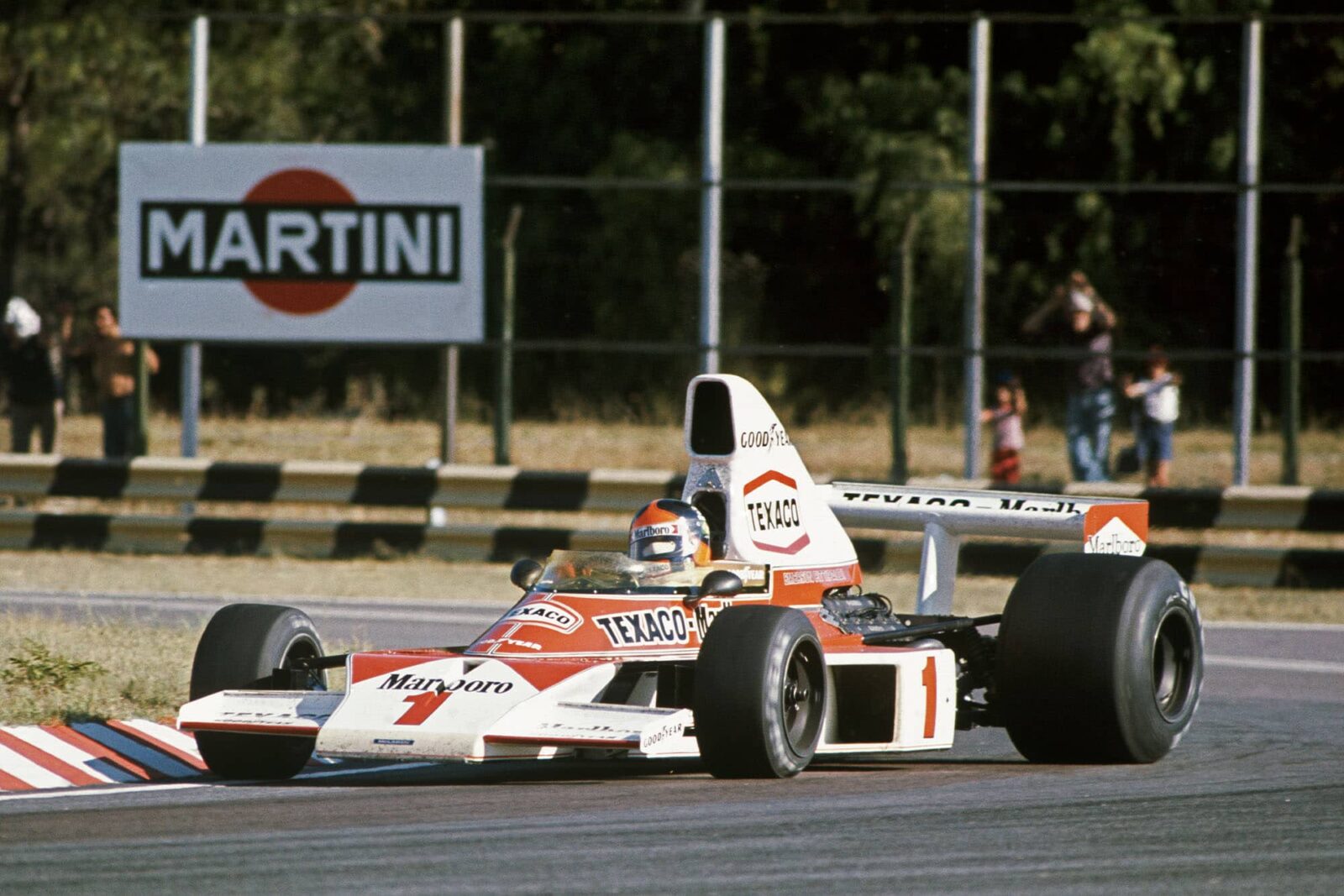
Emerson Fittipaldi won first time out in '75 for McLaren
Motorsport Images
With the first round of the 1975 World Championship taking place in Buenos Aires just three months after the chequered flag fell at Watkins Glen to end the 1974 season it could hardly be expected that many teams would turn up to the Argentine Grand Prix with many new cars. Thus, when the two freighter aircraft had finally been unloaded in South America and the cars rolled out at the circuit, the recipe was very much as had been seen last October in North America. Despite threats of worldwide economic recession, Grand Prix racing seems to be surviving in a remarkably healthy state and, if there has been much paring down amongst the entrants, it seems to have been at the lower quality end of the field than among the faster runners. Obviously the ever inflating expense of competing in Formula One will quickly deter those small and unprofessional organisations who operate neither efficiently nor competitively and thus they are unable to attract the backing necessary for a full season. For those whose cars regularly deliver the results, the immediate prospects seem to be quite sound.
Last year’s Argentine GP looked as though it would be the first Grand Prix victory for Carlos Reutemann who was driving the sleek Gordon Murray designed Brabham BT44 for the very first time. Unfortunately the car succumbed to mechanical trouble with less than two laps to go and the madly enthusiastic crowd was deprived of a home victory. Clearly with this sort of form it seemed inevitable that Reutemann would win a Grand Prix during 1974 and so it proved, with the Brabham driver scoring decisive victories at Kyalami, Osterreichring and Watkins Glen. Mid-way through the last season Reutemann was joined at Brabhams by Brazilian Carlos Pace who had just left Surtees after a huge shouting match, so team owner Bernie Ecclestone was feeling pretty pleased with himself when his two cars finished in first and second places in the United States Grand Prix. One of the things which left some onlookers wondering last year was the fact that Ecclestone had attracted no commercial sponsors to pay towards his team expenses, and although it was nice to see these smartly prepared cars turned out in neat white livery one tended to wonder how and why some far less efficient teams attracted any backing. Well this year things have changed. Ecclestone has concluded a deal with the Martini drinks firm which got its fingers burnt a bit back in 1972 and ’73 sponsoring the abortive Tecno Grand Prix car. Having taken a season oft from Fl and solely sponsored the Porsche turbo-Carreras in 1974, their discreet and tasteful colour scheme will be carried by Ectlestone’s rebuilt Brabham BT44s, now dubbed BT44Bs.
The differences between the BT44 and BT44B are minimal and, indeed, Pace’s BT44B/2 and the spare BT44B/3 are really BT44/3 and BT44/1 respectively having been stripped down and built up to new specification. Although the monocoque retains its familiar triangular profile, it has been substantially stiffened and they now weigh rather less than they d d last year. The familiar semi-inboard front suspension is retained at the front and there are some detail bodywork changes as well.
World Champion Emerson Fittipaldi has stayed with the surviving two-car McLaren team which is still sponsored by Marlboro cigarettes and Texaco fuel although with Hulme’s retirement it has been necessary to appoint a new driver to the second car. The choice thus fell on Jochen Mass, the former Team Surtees driver who deputised for the injured Mike Hailwood in the Yardley McLaren M23 at Watkins Glen” and Mosport Park at the end of last year. Two cars were bought out from the team’s Colnbrook factory, M23/9 being a brand-new car for Fittipaldi featuring a narrower rear track and brand-new front suspension, similar to the Brabham BT44B set up, while Mass relied on M23/8, the car driven by his team leader in the latter half of 1974.
Team Lotus brought along their pair of “old faithful” Lotus 72s, Peterson using R8 and Ickx driving R5, exactly the same machines as they were using at the same event twelve months earlier. Minor alterations had been made to the car’s front suspension but, apart from a few detail changes, the most important of which was larger front brakes with stronger shafts and a different “strap drive” system the cars are vitually the same as last year. The `lightweight” 72/R9 has not yet been completed and the planned new design which Lotus badly need to keep them in contention this year will not be ready until well into the European season. Despite complicated negotiations explained elsewhere in this issue, Peterson did drive a Lotus in this first race of the year and not, a UOP Shadow.
Two other cars which were running in much the same trim as they had appeared in last October’s United States Grand Prix were the Tyrrells. However, Derek Gardner has made one fundamental change in moving the front brakes to an outboard position, this move stemming from the fact that Tyrrells did have a couple of nasty breakages of the strap drive on their inboard discs last season, the one at Mosport virtually wrecking 007/3. Tyrrell’s designer is not convinced that the advantages outweigh the disadvantages and, as neither of his drivers could honestly say they felt any appreciable difference, the alteration was retained.
All through the winter the Ferrari team has been busily testing at its own Fiorano circuit as well as at Ricard and Vallelunga and tales have been filtering back as to just how promising the new transverse gearbox 312T has been looking. On the surface it may thus seem surprising that the Italians did not bring one out to South America, preferring instead to concentrate on their proven and generally reliable 312B3 and not bringing out the new car until the European races start. While Clay Regazzoni drove 014, Niki Lauda had a brand-new 312B3 numbered 020 at his disposal although both cars were prepared to identical specification. The main detail changes for 1975 involved fitting bigger brakes, altering the front suspension slightly in the light of what they have learnt from the 312T project and fitting cast brackets at either side of the rear suspension bridge to carry the top mounting of the coil spring/shock absorber unit. It will be remembered that this was formerly a tubular bracket and the breakage of a single tube was the cause of Lauda’s retirement in Sweden last year when increased weight on the driveshaft caused damage to the crownwheel and pinion and eventually overloaded the gearbox.
Amongst the other brand-new cars was the Singleton Shadow DN5 for Jarier (or Peterson if the exchange had gone through), this latest Tony Southgate design having demonstrated substantial improvements over the DN3 design during tests at Paul Ricard. Inboard front suspension operated by rocker arms is the principal difference between this all-new design and the promising DN3 version, but we are told that the aerodynamics have been improved and Pryce, who was obliged to stick with DN3/3A for the time being, remarked that he couldn’t wait for his to be completed—which it probably will be in time for the South African Grand Prix.
Frank Williams brace of cars for Merzario (FW/03) and Laffite (FW/02) looked much smarter than of late with new nose sections and cockpit tops but were otherwise the same machines that were used by the British entrant last season. Although they carry some discreet advertising from Marlboro, it seems much more of a low-key operation this year and the cars appeared in a smart, predominantly white livery at Buenos Aires. Similarly the Graham Hill Lola team brought along two of its 1974 T370s for the veteran Hill (HU2) and Rolf Stommelen (HU3), this latter chassis having been used as a spare car in 1974. T370/HU1 was back at Hill’s workshops where it has been fitted with a flat-12 Alfa Romeo engine (as a result of Stommelen’s good relations with the Italian team, no doubt) in preparation for a proposed arrangement with the Italian team. Neither of the Lolas looked any different than they had looked at Watkins Glen and were certainly no more effective.
One full season as a constructor obviously left Hesketh Racing with the feeling that something was missing. Their reliability record was absolutely appalling and over the winter it has clearly been quietly resolved that 1975 will be different. Hunt has been testing both cars extensively and they were one of the few teams to arrive in South America with two machines at the disposal of a single driver. Both 308/1 and the race car 308/3 were fitted with side radiators and the full width front wing first seen in Canada last year and Harvey Postlethwaite has developed a progressive rubber suspension medium for the front of 308/3 which replaces the conventional coil spring with 3 shaft operating onto a platform carrying a rubber buffer. Instead of the spring compressing as the suspension takes the load, this rubber buffer takes up the strain and varying characteristics can be made by simply changing to a thicker or softer rubber buffer. Its main advantages are that it is easy to adjust, light and uncomplicated and the team had all the necessary parts on hand to convert 308/1 to this specification if need be.
It is perhaps a sign of the times that an increased number of constructors only fielded single car teams-apart from Hesketh, that is, who just fielded one driver. Team Surtees decided to try and take a steady and reasoned approach with a single revised TS16 for John Watson in an effort to undo all the damage which they inflicted on themselves last year. This chassis is now numbered TS16/04-4, has its radiators angled like the March from the side of the monocoque rather than perched on the rear wings and has been fitted with totally revised suspension all round. Surtees was on hand to direct operations but had decided not to enter a second car until he was confident that Watson was satisfied with the present machine. Having performed an inelegant about-turn over their Formula One plans which were originally said not to exist, March Engineering hastily prepared 13rambilla’s old 741/2-4 for the Italian to: drive under the Beta Tools banner while the “revitalised” BRM organisation put on a brave front and fielded Mike Wilds in BRN1 P201/ 04 in the new colours designed by Mrs. Jean Stanley and her husband.
Having arrived and tried to learn what Formula One was about in the two North American races of last year, both Roger Penske and Parnelli Jones went away and produced two new examples of their Grand Prix chassis with some detail changes although they were both outwardly much the same and driven by Mark Donohue and Mario Andretti respectively. Donohue’s Penske was PC1/02 and Andretti’s Parnelli, which had produced some very encouraging lap times during testing at Ontario Motor Speedway, carried the designation VPJ4/002. Finally, Wilson Fittipaldi, elder brother of the World Champion, was scheduled to make hi S debut in his new Brazilian-built Grand Prix car which is financed by the giant Copersucar combine and has thus been named the “Copersucar-Fittipaldi”. Built almost entirely from components made in Brazil, the Fittipaldi car is striking to say the least and although it is basically a “British standard kit car” using Cosworth and Hewland running gear, it does have several interesting features. Unusually it is clad in a near all-enveloping body which, we are told, was designed with the air of a wind tunnel and carries its water radiators right at the back hung under the rear wing and fed by huge scoops extending forward along the car’s sides. Unfortunately the major snag which cropped up in practice proved to be the fact that one has to bleed the radiator and cooling system in order to change the gear ratios. This was a factor which delayed the car a good deal on the first day of practice.
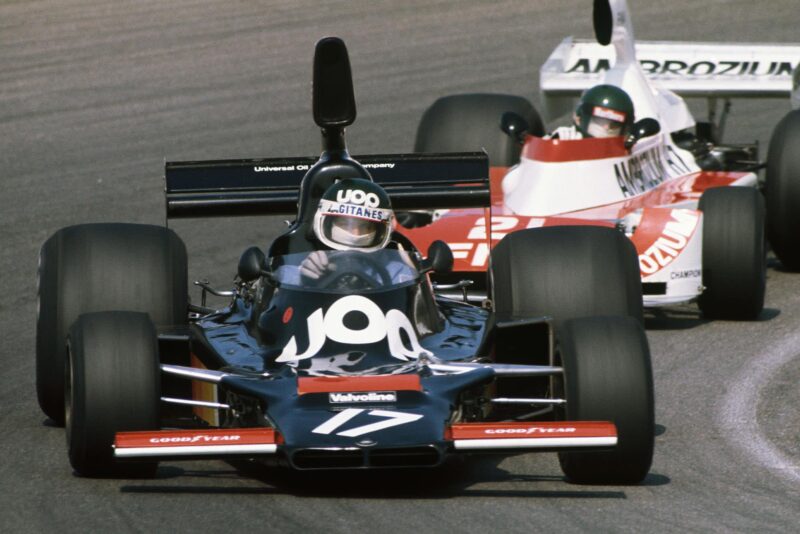
Jean-Pierre Jarier put his Shadow F1 car on pole for the season opener
Motorsport
Official practice round she 3.7-mile number 15 circuit in the Parque Almirante Brown took place in the late afternoon on Friday and Saturday with vast crowds flocking in on each occasion to cheer for Reutemann. Everyone quite naturally reasoned that, as he had been testing at Buenos Aires the preceding week, Reutemann and his Brabham would pose a strong threat on home ground. That reasoning proved quite correct in the first session when Reutemann hurled his way round in an impressive 1 min. 49.93 sec. to head the practice list. Both Brabhams were briefly delayed when their cockpit fire extinguishers were inadvertently set off, but this did not prevent “Lole” from amply demonstrating his mettle in front of his delighted supporters.
However, the Martini Brabhams were definitely not going to have everything their own way. From the moment he was let out onto the circuit, Jarier had the new Shadow wound up and really flying in spectacular fashion. Braking as late as anyone into the tight corners on the infield loop section, Jarier was powering his way onto the straights with armfuls of opposite lock and his right foot hard on the throttle pedal. He looked highly spectacular, bordering on the imprudent, but the timekeeper announced that his best time was 1 min. 50.21 sec. which stood him in as second quickest in the first session.
James Hunt was determined not to get left behind on this occasion either and even though he had to hurry back to the pits on foot when his spare Hesketh stranded him at the far end of the circuit with a jammed fuel relief valve. He immediately climbed into 308/3 and managed 1 min. 50.86 sec. which was fractionally better than Lauda could achieve in his Ferrari which wasn’t handling as well as he would have liked. The weather was extremely cool on Friday afternoon which meant that most of the sub-1 min. 50 sec. laps were more likely to be established in these conditions rather than the intense heat which most people had expected in the middle of an Argentinian summer. Sure enough, Carlos Pace joined this select band with a fine spurt in 1 min. 49.64 sec. during the second session on Friday although the biggest surprise had yet to come.
Many sceptics suspected that Jarier’s effort in the new Shadow was a “win or bust” effort which he would be unlikely or unable to repeat. But out went the black DNS at the start of the second session and, driving in that same spectacular style, not only did Jarier repeat the dose but he actually improved on it and pipped Reutemann at the head of the list with a fine 1 min. 49.21 sec. Having regard to the relative case with which the Frenchman drove round to a quick time, one couldn’t help but reflect precisely what Ronnie Peterson would have done with the car had he agreed to drive it. But Peterson had plenty to think about down in the Lotus pit without “crying over spilt milk”—if spilt milk there be—for his Lotus 72 was bugged with braking problems on Friday and the Swede’s efforts to get to terms with his machine’s violent oversteer resulted in a huge spin on the fastest corner on the circuit. He also lost one of his nose fins which promptly clattered back and punctured a rear tyre, so Peterson had to work pretty hard to record 1 min. 51.65 sec.
Lauda improved to 1 min. 50.80 sec. in the second session only to be “jumped” by the unobtrusive Emerson Fittipaldi (1 min. 50.74 sec.) and Patrick Depailler Cl min. 50.08 sec.), the little Frenchman going really well in his Tyrrell. By contrast Scheckter was having a troubled time with a long delay while a faulty gearbox bearing was sorted out, Regazzoni was further out of the picture than usual and the engine in Mass’ McLaren M23 blew up just before the end of the second session although he hadn’t been exactly impressive up to that point. From Scheckter on 1 min. 51,81 sec. there was a huge gap back to Pryce (1 min. 53.34 sec.) punctuated only by Mass on 1 min. 52.49 sec. Anyone below the 1 min. 54 sec. barrier really had a great deal of work in front of them.
Saturday dawned extremely bright and warm, so it seemed unlikely that anyone would beat Jarier’s Friday time and so it proved with Emerson Fittipaldi slicing within a couple of hundredths of a second off the 1 min. 50 sec. barrier to top the chart. The irrepressible Jarier simply underlined yet again that his performance on Friday was no “flash in the pan” by pulling a 1 min. 50.22 sec. lap out of the barrel just to remind everyone he was still around while Pace, Reutemann and Lauda all lapped under the 1 min. 51 sec. barrier which was really very impressive in the conditions. Hunt managed a 1 min. 50.81 sec. while both the Tyrrell drivers complained that the warmer track surface had converted their good-handling Tyrrells into oversteering nightmares without any adjustments having been made to their suspension.
Peterson’s unceasing efforts just couldn’t bring the Lotus 72 down into the 1 min. 50 sec. bracket but Andretti found that at least he was going in the right direction and sliced his PanteIli down to 1 min. 51.68 sec. By contrast Mark Donohue was looking as glum as could be for not only did the Penske seem a long way “out of the ball park” but its handling looked erratic and unpredictable out on the circuit. Mass was simply not very impressive and wasn’t lapping all that quicker than the determined Watson in his Surtees while the two Williams cars were surprisingly slow, Ickx didn’t look any more interested than he’d been for much of last year and both Lolas plus the BRA,’ really needn’t have bothered to come along. At least the Copersucar Fittipaldi had the excuse that it was in its first race and was a brand-new car from a brand-new team which had not competed at the circuit before.
In the final hour everyone in the huge grandstand opposite the pits was cheering madly for Reutemann, hoping fervently that he would go out and at least secure himself a place on the front row. But the dye had been cast and there was no way he could equal Pace’s best, let alone Jarier’s fastest. But he did make a terrific effort that warm evening and improved to 1 min. 49.80 sec. although this didn’t alter his place on the grid. Even more impressive was Lauda’s effort for, in the dying seconds of that final session, he stood the Ferrari “on its car” to grab fourth place on the grid with a fine 1 min. 49.96 sec. Fittipaldi’s efforts to get below 1 mm. 50 sec. were thwarted at the last moment by a loose wheel, so while he didn’t qualify as one of the four “aces” he at least led the “heroes” in the 1 min. 50 sec. bracket. On the outside of the fifth row, Andretti’s 1 min. 51.06 sec. meant that he missed being a “hero” by 0.06 sec. but at least led the “triers” and anyone who didn’t break 1 min. 52 sec. could just about count themselves out of the serious contest.
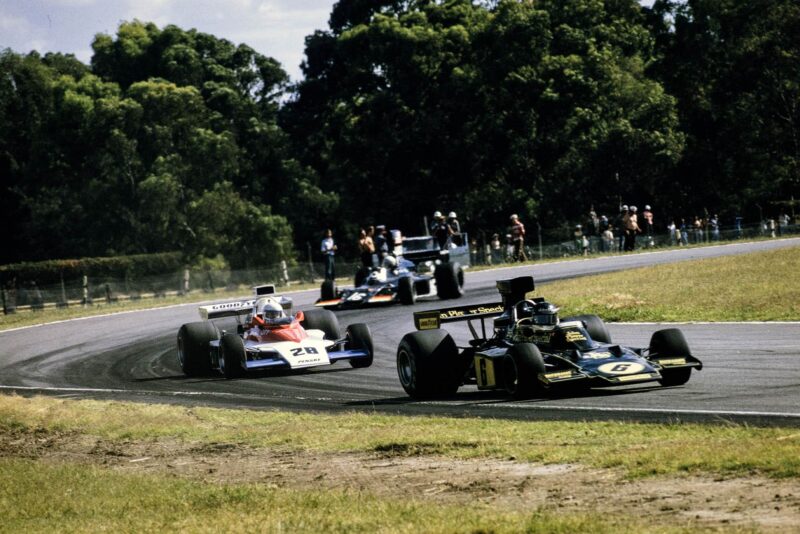
Jacky Ickx leads Mark Donohue and Tom Pryce
Motorsport Images
As usual there was an untimed half-hour session on race morning which served to bed in brakes, run in fresh engines and try out new gear ratios although anyone who wasn’t ready to go by this stage probably never would be ready. Just to ensure everything was right for Jarier, the Shadow mechanics fitted a brand new crownwheel and pinion to the black car, so their pain can be imagined when the car glided to a halt almost before it had started its warming up lap a few yards from the pit exit. The mechanics, led by Alan Rees, sprinted down to assist their man, but a quick examination revealed that the new pinion had stripped all its teeth, so Shadow’s big effort had stopped before it had even started and Jarier could be forgiven for being on the verge of tears at such an amazing course of events.
However, nobody was there to stand around commiserating, this was the start of a Grand Prix and as far as the crowds were concerned, Jarier’s almost un-noticed absence meant that Reutemann had a clear track in front of him when the flag dropped. Surging ahead of team-mate Pace, “Lole” took the lead into the first corner cheered on by his patriotic supporters while Lauda, Hunt and Fittipaldi jostled for position behind him. In the pushing and shoving on that opening lap, Mass ran into the back of Scheckter with the result that both had to stop at their pit first time round while Watson’s Surtees didn’t even make it round to the timing line for the first time as a fuel line became disconnected and he rolled to a silent standstill. Over the line at the end of the first lap, the two Martini Brabhams made a ,fine sight in line astern formation with Lauda striving to stave off Hunt and Fittipaldi being tailed by Peterson.
Already there was a slight gap back to Regazzoni, Depailler and Andretti while Mass went straight in to acquire a fresh nose cone as Brambilla, Ickx, Donohue, Pryce and the two Williams cars rushed through nose to tail and then came the Lolas split by Scheckter’s Tyrrell which needed a fresh right rear tyre. Already dropped by the rest was Wilson Fittipaldi, but at least the Copersucar was running smoothly, while suddenly everyone was surprised that Mike Wilds came pounding through all on his own. The BRM had suffered a fuel vapour lock on the grid and had been pushed to its pit for attention before setting off half a lap behind the rest. As mechanics made their way out to Watson’s stricken Surtees, and thus resulted in his eventual disqualification, the crowd were busy heaping applause on the two Brabhams as they continued to dominate the race from the front. However, Lauda was finding things a bit marginal as he struggled to keep ahead of Hunt for the Hesketh was diving deep in behind him under-braking for the tight corners and it seemed only a matter of time before the British driver went through. Sure enough, on their eighth-lap. Hunt was in third place and then started to hound the Brabhams for all he was worth.
Peterson’s Lotus was hanging on like grim death behind Fittipaldi’s McLaren, but it was clear that he couldn’t keep this sort of pace up for long although he was going away from Brambilla at a very fast rate. Right at the back, Wilson Fittipaldi was having a lonely run in the Copersucar all on his own and just as he began to think that perhaps everything was beginning to run right for a change, the car simply spun into a barrier for no apparent reason as the car accelerated along the short straight behind the paddock. Smashing backwards into the guard rail at a distinctly unhealthy pace, the Copersucar almost immediately burst into flames and Wilson Fittipaldi quickly scrambled out, feeling very bewildered as to the accident’s cause and very upset as to its result.
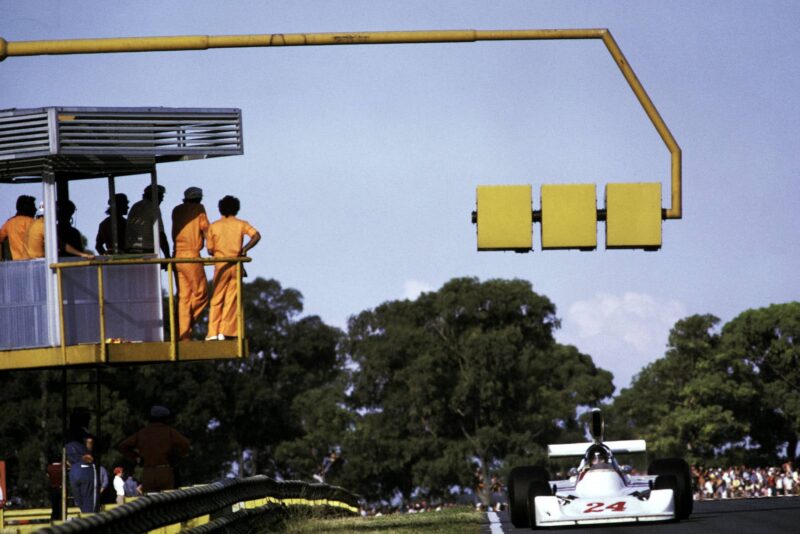
James Hunt placed an impressive 2nd in his Hesketh
Motorsport Images
As fire extinguishers gradually got the conflagration under control, the leaders continued to thread their way through the thick black smoke and Pace began to move in on his team-mate. Slight suspension adjustments made before the start of the race to ease rear tyre wear on Reutemann’s car left the Argentinian with a trace too much understeer and now that problem was beginning to slow him. On lap 14 he could hold up to Pace no longer and the Brabham 1-2 reversed itself briefly. No sooner had Pace taken the lead than he spun it away on the curve after Wilson Fittipaldi’s accident, apparently on debris and extinguishant from the crash. This allowed Reutemann back into the lead, now challenged hard by Hunt and on lap 22 Fittipaldi came up to join them having passed Lauda’s Ferrari. In the commotion surrounding the Copersucar’s accident, Peterson had gone missing, his Lotus 72’s motor having suffered a severe internal breakage, probably in the valve gear.
This was top-class Grand Prix racing with sustained interest at just about every level in the field. The leaders kept everyone on tenterhooks with Hunt trying to make his cheeky way past Reutemann on every corner, Fittipaldi wasn’t very far behind and Lauda was beginning to look under pressure from Regazzoni and Depailler. Andretti was admittedly running alone, destined to retire with a broken universal joint on a driveshaft after 27 laps, but Brambilla, Ickx, Donohue and Merzario were enjoying a good “tear-up” and Scheckter, despite having to come in on two more occasions for a fresh rear tyre owing to bent rear suspension, kept charging up through the backmarkers only to be delayed again by his next stop. All in all, there were a lot of people doing a great deal of energetic motoring.
Clearly worried about his brother, Emerson Fittipaldi eased off just a little for the next few laps, but when McLaren mechanics hung out a “Fitti OK” sign to their team leader, he immediately responded by dosing in on Hunt. On lap 25 the Hesketh driver found a way through into the lead and Fittipaldi immediately followed him, pushing the understeering Reutemann back into third place. Wilds’ BRM had its scavenge pump seize as he was approaching the hairpin, squirting out most of its lubricant onto the circuit and Tom Pryce’s Shadow had a lurid moment under-braking although the driver was able to regain control again.
Round and round went the two leaders, Hunt driving calmly and smoothly, apparently unruffled by the attentions of the World Champion on his heels. Even when they lapped Mass on lap 32, Hunt kept his head and foiled the German’s brief effort at helping his team-mate. But Fittipaldi was gradually screwing on the pressure. On lap 34 both drivers set their fastest lap of the race and on lap 35 Hunt spun at the hairpin allowing Fittipaldi through. From that point on, although the Hesketh driver recovered with the minimum of delay, there was nothing he could do about redressing the situation in the remaining 18 laps.
Pace by now had recovered to fourth place behind Reutemann, having forced his way past the two Ferraris, and it looked as though he might have another go at Reutemann. Unfortunately lap 46 marked the end of Pace’s aspirations as he stopped just after the pits when his engine. failed. All that was left was for Depailler to fight his way past Lauda’s erratic-handling Ferrari with less than ten laps to go and finalise the order of those who were to score Championship points.
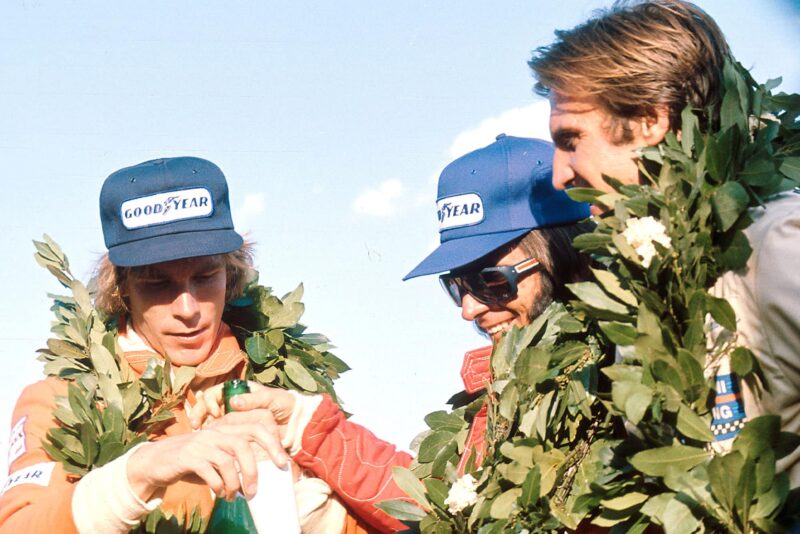
Fittipaldi flanked by Hunt (left) and Carlos Reutemann (right) on the podium
Motorsport Images
Starting off 1975 on the best possible note, Emerson Fittipaldi took the chequered flag to beat Hunt by just under six seconds in what might be described by Hunt’s fans as a “lucky race” and by his own fans as “tactical win”. One way or another he had certainly driven with great confidence and deserved his place in the winner’s circle after this fascinating race of changing fortunes. With all the teams bar Andretti’s running on Goodyear rubber now, many inequalities have now hen evened out so this tremendously close race bodes well for the rest of 1975. Despite being at a point of technical stagnation, Grand Prix racing is as intense and competitive as it has ever been.— A.H.